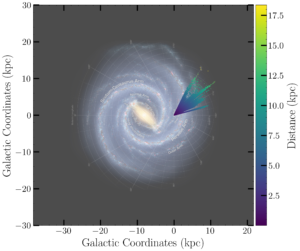A team of Irish physicists using the state-of-the-art Irish LOFAR telescope have scanned 1.6 million star systems that previous efforts have flagged as interesting targets to look for evidence of alien technology. Part of the Breakthrough Listen project, this latest Search for Extraterrestrial Intelligence (SETI) effort was the first to scan at much lower radio frequencies, something previous efforts were not equipped to do.
Although no definitive signs of alien technology were discovered, these 1.6 million star systems were just the tip of the iceberg. In fact, the researchers involved say they are already upgrading their equipment to widen the searchable radio frequency spectrum even further.


CREDIT: I-LOFAR
Searches for Alien Technology Fueled by Growing Evidence For Extraterrestrial Life
The press release announcing the Trinity College of Dublin team’s research points out that various attempts to listen for radio waves from other star systems date back over 60 years. Once considered a fringe scientific pursuit at best and a tragic waste of time and talent at worst, they also note that such efforts to search for alien technology have slowly but surely been bolstered by a growing body of scientific evidence for the conditions for life being common in the cosmos.
“In the last 50 years, evidence has steadily mounted that the constituents and conditions necessary for life are relatively common in the Universe,” explained Professor Evan Keane, Associate Professor of Radio Astronomy in Trinity’s School of Physics, “which begs one of life’s greatest unanswered questions: are we really alone?”
As a result, more and more mainstream scientists are looking for that answer. Some efforts include searching for the building blocks of life or atmospheric signatures of active biology like those found in the clouds of Venus or, more recently, the “biosignature” gas dimethyl sulfide found in the atmosphere of distant exoplanet K2-18b. Others include looking for signs of ancient habitability on Mars or even current clues about habitability in the seas of Europa, Ganymede, and Enceladus, all moons in our solar system.
Searches for alien technology, often referred to as “technosignatures,” include proposals to use the Laser Interferometer Gravitational-Wave Observatory (LIGO) to search for ripples in space/time left in the wake of alien spacecraft or the more traditional method of searching the heavens for electromagnetic emissions like radio waves. This latest effort builds on that line of work, only with the benefit of focusing on interesting targets identified by other telescopes and the ability to search a broader range of radio wave frequencies.
Broader EM Spectrum Sensitivity Enabled More Precise Scanning of 1.6 Million Star Systems
In their published work, which appeared in the Astronomical Journal, the researchers point out that much of the previous work in SETI has focused on frequencies above 1 GHz because “the single-dish telescopes employed operate at these frequencies.” Instead, the team says their array of multiple telescopes allowed them to scan frequencies as low as 110 – 190 MHz, which is much lower than any previous SETI team has looked.


CREDIT: Owen Johnson and Evan Keane, Trinity College Dublin
They also note that having multiple telescope arrays focusing on the same star system offers other advantages. For instance, many SETI efforts encounter “false positives” due to radio waves from Earth that were misread and classified as potential signs of alien technology. Using multiple arrays at once dramatically reduces the chances of this type of misidentification.
“What makes surveys like this one truly captivating is the fact that we’re pushing these telescopes to their absolute limits, directing them towards substantial portions of the sky,” said Owen Johnson, Ph.D. Candidate in Trinity’s School of Physics and the study’s first author. “As a result, we have the exciting possibility of discovering all sorts of wild and wondrous phenomena during this process and, if we’re very fortunate, even encountering our cosmic neighbours.”
New Upgrades Will Push The Limits Even Further, Increasing the Odds of Finding Alien Technology
Moving forward, the researchers say that the work they have done thus far is just the beginning. Towards that end, they plan to upgrade their equipment to increase their overall scanning capabilities.
“LOFAR is soon to undergo a staged series of upgrades across all stations in the array across Europe, which will allow an even broader SETI at ranges of 15 – 240 MHz,” said Johnson. “We have billions of star systems to explore and will be relying on some machine learning techniques to sift through the immense volume of data.”
Johnson notes that using AI to search for signs of alien technology is in and of itself a novel undertaking.
“That in itself is interesting,” he said. “It would be fairly ironic if humankind discovered alien life by using artificial intelligence.”
Ultimately, the effort to look for signs of intelligent life in the cosmos seems to be gaining steam. Considering how long it spent on the fringe before overwhelming evidence forced mainstream scientists to take it more seriously, it is a welcome change.
“To some people, the ‘Search for Extra-terrestrial Intelligence, or SETI’ might seem like something from a movie, but it has been a scientific pursuit for decades, and for a host of very good reasons,” said Keane. “With this project, we are basing our search on the common assumption that civilisations elsewhere in the Universe may employ similar technologies to those developed on Earth. As a result, radio frequencies are a logical domain for conducting SETI surveys due to the widespread use of telecommunications and radar, and our access to next-gen radio telescopes offers a great chance for a deep dive into the Universe.”
Christopher Plain is a Science Fiction and Fantasy novelist and Head Science Writer at The Debrief. Follow and connect with him on X, learn about his books at plainfiction.com, or email him directly at christopher@thedebrief.org.

